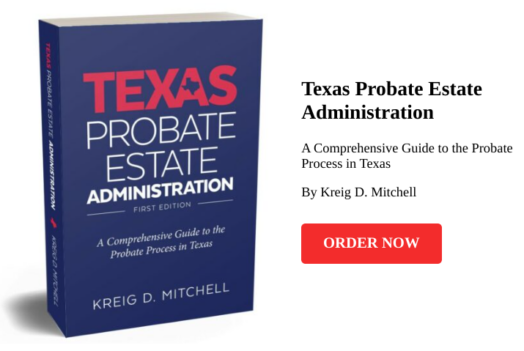When a loved one passes away in Texas, their will typically undergoes routine probate proceedings. Most wills follow a predictable format—several pages of bequests and instructions, concluding with a signature line where the testator signs above their printed name, followed by witness signatures. But what happens when the testator’s signature appears somewhere unexpected, perhaps on a separate page that contains no actual provisions of the will?
This question might seem like a mere technicality, but it can determine whether an entire estate plan stands or falls. Texas law requires specific formalities for a valid will, including that it be signed by the testator. When family members discover that their loved one signed the will on what appears to be a separate signature page, rather than at the end of the dispositive provisions, they may wonder whether the document can still be probated. Does the signature’s unusual location invalidate the entire will?
The recent case of In the Estate of Edward C. Curry, Deceased, No. 10-23-00207-CV, 2025 WL 2473024 (Tex. App.—Waco Aug. 28, 2025), provides an opportunity to examine how Texas courts evaluate will validity when signatures don’t appear where we might expect them.
Facts & Procedural History
The decedent died in 2022. He was survived by three adult children, including his daughter Emberlee. The decedent had executed a will in 2021, in the presence of three witnesses. After the decedent died, his daughter filed an Amended Application for Probate of Will and for Letters of Administration with Will Annexed.
One of the other children opposed the application and challenged the validity of the 2021 will. Among her various challenges, she argued that the will was invalid because the decedent’s signature appeared on the second page of the document, which contained no provisions of the will itself. The first page contained all the dispositive provisions—the actual terms stating who would receive what from the estate—while the second page bore only the signatures of the testator and the three witnesses.
At trial in June 2023, the court admitted the 2021 will into evidence over objections. All three subscribing witnesses testified orally in court about witnessing the decedent sign the will and signing it themselves at his request. The jury found the will to be valid and enforceable. The appeal focused on several issues, including whether the jury erred in concluding the will met statutory requirements when the testator and witnesses signed on a separate page from the will’s provisions.
The Statutory Framework for Will Execution in Texas
Section 251.051 of the Texas Estates Code sets out the requirements for a valid will. It says that a will has to be in writing, signed by the testator in person, and attested by two or more credible witnesses who are at least 14 years of age. These witnesses must subscribe their names to the will in their own handwriting in the testator’s presence.
Many of the disputes involving signatures involve questions about the signature itself. For example, whether a signature that is a rubber stamp can suffice. There are other disputes, like this one, as to the location of the signature on the will.
The statute itself doesn’t specify where on the document the testator’s signature must appear. It doesn’t require the signature to follow immediately after the last bequest or appear on the same page as the dispositive provisions. This statutory silence has left room for interpretation by Texas courts over the years.
The absence of specific placement requirements reflects a practical reality of will drafting. Wills come in many formats, from simple one-page documents to complex multi-page instruments with numerous provisions and schedules. Requiring signatures in a particular location could inadvertently invalidate wills that clearly express the testator’s intent but don’t conform to rigid formatting rules. The statute’s flexibility allows courts to focus on substance over form.
When Multiple Pages Raise Questions About Document Unity
The challenge arises when a will spans multiple pages and signatures appear on a page separate from the substantive provisions. Texas courts have to determine whether the pages constitute a single, unified document or separate documents that fail to meet statutory requirements. A signature on an entirely separate document cannot validate a will that lacks the testator’s signature.
To address these cases, the courts examine both physical and contextual evidence to determine document unity. Physical connections might include staples, sequential page numbering, or consistent paper type and formatting throughout. Contextual indicators include whether provisions flow from one page to another, whether pages reference each other, or whether any page contains markers suggesting it stands alone as a complete document.
The analysis is more complex when pages lack obvious physical or textual connections. A signature page with no will provisions might appear to be a standalone document. This is especially true if it could theoretically be attached to any will. Courts have to then look deeper into the circumstances surrounding the will’s execution to determine whether the testator intended the signature page to be part of the specific will being offered for probate.
When Pages Are Truly Separate
The case of Ajudani v. Walker established important precedent for determining when pages constitute separate documents rather than a unified will. In that case, the purported will consisted of seven pages, with the seventh page bearing the signature but appearing to be a distinct document. The court identified several factors that indicated separation.
The seventh page in Ajudani was written on a different type of paper than the preceding six pages. The sixth page contained a postscript and a carbon copy designation, suggesting it was intended as the final page of the letter that comprised the will. The seventh page also lacked the category headings marked by circled numbers that appeared on all previous pages. These physical and formatting differences led the court to conclude that the signature page was a separate document that couldn’t validate the unsigned will.
This ruling established that courts should look for objective indicators of whether pages form a cohesive whole. The presence of multiple factors suggesting separation—different paper, inconsistent formatting, textual markers of finality—supports finding separate documents. Conversely, the absence of such factors suggests unity, even when signatures appear on an otherwise blank page.
Applying These Principles in the Curry Case
The appeals court examined whether the 2021 will met statutory requirements despite the signature appearing on a second page containing no will provisions. The contestant argued this arrangement meant the will wasn’t properly signed, comparing it to the invalid will in Ajudani.
The court distinguished the will from the document in Ajudani. Unlike Ajudani, where multiple factors indicated the signature page was a separate document, the will in this case showed clear signs of unity. The second page containing the signatures was stapled to the first page containing the dispositive provisions. Both pages were written on the same type of paper. No markers suggested the first page was intended as a complete, standalone document.
The court also relied heavily on witness testimony. All three subscribing witnesses testified orally in court. They confirmed they witnessed the decedent sign the will, that he asked them to sign as witnesses, and that he declared the document to be his last will and testament. This testimony established that the decedent intended his signature on the second page to authenticate the entire two-page document as his will.
The Takeaway
This case is a reminder that Texas courts will look beyond formatting technicalities to determine whether a will was properly executed. While it’s certainly preferable for estate planning attorneys to follow conventional formatting—placing signatures immediately after the last dispositive provision—unconventional signature placement doesn’t automatically invalidate a will.
For those drafting wills, the best practice remains creating documents where the signature’s relationship to the will’s provisions is unmistakable. This might mean including language on the signature page referencing the will’s provisions, numbering pages to show continuity, or ensuring some dispositive language appears on the signature page itself. These practices minimize the risk of challenges based on signature placement.
Do you need help with a probate dispute in Houston or the surrounding area? We are Houston litigation attorneys. We help clients navigate even the most complex estates. Call today for a free confidential consultation, 281-219-9090.
Our Houston Probate Litigation Attorneys provide a full range of services to our clients, including helping with will contests and estate planning. Affordable rates, fixed fees, and payment plans are available. We provide step-by-step instructions, guidance, checklists, and more for completing the probate process. We have years of combined experience we can use to support and guide you with guardianship and probate matters. Call us today for a FREE attorney consultation.
Disclaimer
The content of this website is for informational purposes only and should not be construed as legal advice. The information presented may not apply to your situation and should not be acted upon without consulting a qualified probate attorney. We encourage you to seek the advice of a competent attorney with any legal questions you may have.











